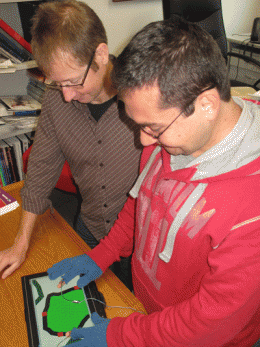New device puts vision impaired in the picture

(PhysOrg.com) -- Visually impaired people may soon have greater access to graphical information thanks to a new device developed by Monash University’s Faculty of Information and Technology.
The device, called GraVVITAS, is a standard tablet PC with touch screen technology that uses vibration and sounds to guide the visually impaired user around a diagram.
It is designed to enable the user to build a picture of the entire graphic in their mind.
Currently, visually impaired students are using tactile diagrams to understand graphics. These raised shapes and textures are produced on a particular type of paper by special purpose printers, known as embossers. This method can prove to be extremely costly and can take months to produce a textbook.
The Faculty of Information and Technology’s Professor Kim Marriott and PhD student Cagatay Goncu are working with Vision Australia to develop the new technology, that will make accessing diagrams for visually impaired students easier.
“The idea stemmed from a visually impaired student that I had years ago in a unit that was very diagrammatic,” Professor Marriott said.
“This particular student had major problems understanding the diagrams using the methods that were available to them at the time. We wanted to try to increase accessibility to diagrams and graphics in educational material, which is a huge issue for the visually impaired.”
The device, which is currently a prototype, has small external vibrating motors that attach to the user’s fingers. These motors buzz when an object displayed on the screen is touched.
Cagatay Goncu said voice prompts and sounds also help to guide the user to read the diagram.
“The basic idea is to guide the user to find the object by using sound. Touching the object causes the sound to stop and a voice explains what that object is and any other information associated with it,” Mr. Goncu said.
“If it’s something on the left side, you will hear something in your left ear and vice-versa.”
Developing the technology has involved extensive testing with visually impaired volunteers, which has allowed researchers to have a better understanding of how they read diagrams.
The next stage of development will involve collaborating with haptic feedback specialists from the Faculty of Engineering who will further refine the touch technology associated with the device.
Provided by Monash University
















